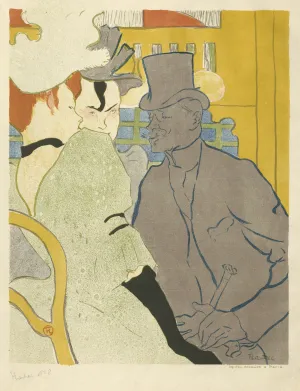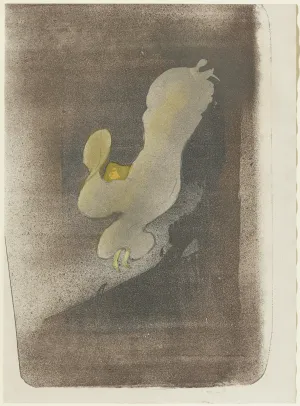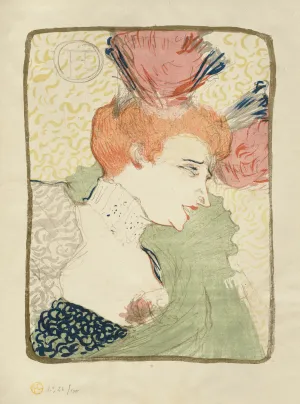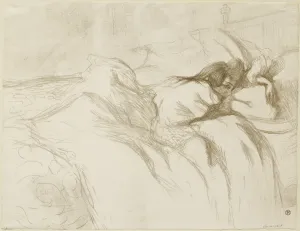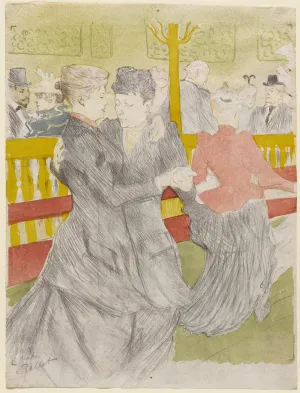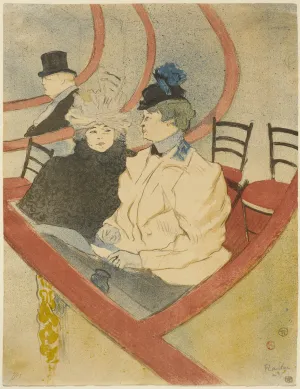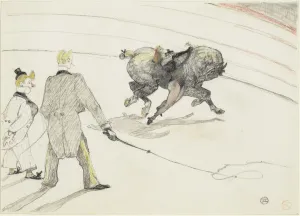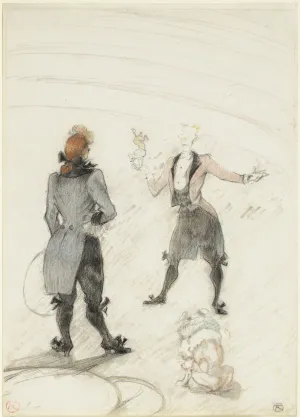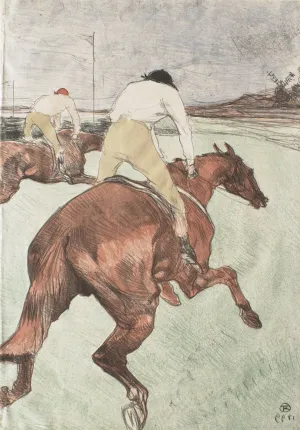Toulouse-Lautrec
Masterpieces of Lithography by Henri de Toulouse-Lautrec (1864–1901)
Of aristocratic descent, Henri de Toulouse-Lautrec immersed himself in the world of Parisian dancehalls, brothels, and cafés and created indelible images of its inhabitants. Deftly working on the multiple stones required to make a lithograph of more than one color, he developed a distinctive graphic style characterized by a bright palette, attenuated forms, and expressive line. His inventive methods of spraying ink onto the printing surface to create mists of color and employing metallic powders result in dazzling atmospheric effects. In these works, he offers an insider’s view of Paris’s underbelly, where different classes intermingle and spectacle has a place both on and off stage. Matching the modernity of his subjects with an unmistakably modern style, he defined the image of fin-de-siècle Paris for all subsequent generations.
Henri de Toulouse-Lautrec (1864–1901)
The Englishman at the Moulin Rouge, 1892
Lithograph printed in black, green, gray, blue, orange-red, and yellow on cream laid paper
Sheet: 23 1/2 x 18 1/16 in. (59.7 x 45.9 cm)
Sterling and Francine Clark Art Institute, Williamstown, Massachusetts, 1968.17
To contemporary viewers, Toulouse-Lautrec’s inclusion of recognizable figures in his scenes of famous Parisian nightspots added another level of interest. The cropping of the image enhances the sense of immediacy by bringing the viewer into the conversation between the two protagonists. The man’s inclined posture and leering expression make clear the nature of their exchange.
Henri de Toulouse-Lautrec (1864–1901)
Miss Loïe Fuller, 1893
Lithograph printed in blue-gray, brown-aubergine, and yellow, touched with gold and silver powder on cream wove paper
Sheet: 15 1/16 x 11 1/16 in. (38.2 x 28 cm)
Sterling and Francine Clark Art Institute, Williamstown, Massachusetts, 1962.105
In this highly experimental lithograph, the sequential movement of Loïe Fuller’s famous stage performance in a voluminous transparent garment manipulated by long poles is captured in a swelling form that approaches abstraction. The addition of gold and silver dust to the print enhances the ethereal effect.
Henri de Toulouse-Lautrec (1864–1901)
Mademoiselle Marcelle Lender, Bust-Length, 1895
Lithograph printed in brown-green, yellow, red, dark pink, green, blue, gray, and yellow-green on cream wove paper
Sheet: 19 9/16 x 14 ¾ in (49.6 x 37.5 cm)
Sterling and Francine Clark Art Institute, Williamstown, Massachusetts, 1955.1442
This actress and dancer — a late-life passion of the artist’s — appears in many of his works, most famously dancing the bolero. The color harmonies that set off her vivid orange hair, pale powdered face, and décolletage in this close-up portrait reveal Lautrec’s tenderness for his subject.
Henri de Toulouse-Lautrec (1864–1901)
Frontispiece from Elles, 1896
Lithograph printed in olive green, blue, and orange on cream wove paper
20 11/16 x 15 13/16 in. (52.5 x 40.2 cm)
Sterling and Francine Clark Art Institute, Williamstown, Massachusetts, 1962.107
A monument in modern printmaking, Toulouse-Lautrec’s Elles portfolio has been interpreted as a chronicle of the daily lives of lesbians involved in the worlds of prostitution and entertainment. The evocative image of a woman in nightdress letting down her hair, seen from behind, in combination with the presence of a man’s top hat introduces one of the themes.
Henri de Toulouse-Lautrec (1864–1901)
Woman Reclining — Waking Up, from Elles, 1896
Lithograph printed in gray on cream wove paper
15 13/16 x 20 5/8 in. (40.2 x 52.4 cm)
Sterling and Francine Clark Art Institute, Williamstown, Massachusetts, 1962.110
Here the rectangle of the sheet serves as the shape of a bed. From underneath a heap of disheveled bedclothes suggested by a nearly abstract pattern of undulating lines, the shaded, profiled head of a woman and a lax arm emerge. Through a half-opened eye, she regards the viewer/artist and presumed client with an air of familiarity.
Henri de Toulouse-Lautrec (1864–1901)
The Seated Clowness (Miss Cha-U-Kao), from Elles, 1896
Lithograph printed in green-black, black-brown, yellow, red, and blue on cream wove paper
20 11/16 x 15 13/16 in. (52.5 x 40.2 cm)
Sterling and Francine Clark Art Institute, Williamstown, Massachusetts, 1962.108
This sheet features the contortionist dancer Miss Cha-U-Kao (a phonetic play on chahut-chaos or chaotic can-can). She is shown at rest, her outlandish costume, provocative pose, and brazen stare conveying her strong personality. Sharp outlines are set off against soft atmospheric effects achieved through a technique of blowing fine dots of ink on a lithographic stone.
Henri de Toulouse-Lautrec (1864–1901)
Dance at the Moulin Rouge, 1897
Lithograph printed in gray-black, blue-gray, red, yellow, and green on cream wove paper
18 1/2 x 14 in. (47 x 35.5 cm)
Sterling and Francine Clark Art Institute, Williamstown, Massachusetts, 1962.119
Miss Cha-U-Kao is shown here waltzing with her lover in a moment of leisure at the Moulin Rouge. Their nearly identical walking suits and the shared contour line dividing them convey the couple’s intimacy.
Henri de Toulouse-Lautrec (1864–1901)
Box in the Grand Tier, 1897
Lithograph printed in black, orange-red, blue, beige, and yellow on cream wove paper
20 1/4 x 15 9/16 in. (51.4 x 39.5 cm)
Sterling and Francine Clark Art Institute, Williamstown, Massachusetts, 1962.118
In this print, another example of the artist’s blurring of portrait and genre scene, the plush red balustrade of a theater box frames two well-known demimondaines attending a performance.
Henri de Toulouse-Lautrec (1864–1901)
At the Circus: Acrobats, 1899
Black and color chalks on white wove paper
9 15/16 x 14 in. (25.3 x 35.5 cm)
Sterling and Francine Clark Art Institute, Williamstown, Massachusetts, 1955.1429
This circus scene, along with At the Circus: The Dog Trainer, belongs to a large group of drawings that Toulouse-Lautrec made from memory while he was recuperating in a medical clinic from alcoholism and a mental breakdown. The attenuated bodies and expressive gestures of the figures reveal the artist’s undiminished mastery of line.
Henri de Toulouse-Lautrec (1864–1901)
At the Circus: The Dog Trainer, 1899
Black and color chalks, over graphite, on white wove paper
14 x 9 15/16 in. (35.5 x 25.3 cm)
Sterling and Francine Clark Art Institute, Williamstown, Massachusetts, 1955.1427
This circus scene, along with At the Circus: Acrobats, belongs to a large group of drawings that Toulouse-Lautrec made from memory while he was recuperating in a medical clinic from alcoholism and a mental breakdown. The attenuated bodies and expressive gestures of the figures reveal the artist’s undiminished mastery of line.
Henri de Toulouse-Lautrec (1864–1901)
The Jockey, 1899
Lithograph printed in black, green, red, brown, beige, and blue on cream wove paper
20 5/16 x 14 3/16 in. (51.6 x 36 cm)
Sterling and Francine Clark Art Institute, Williamstown, Massachusetts, 1962.122
The bold foreshortening of the horse and its diagonal thrust convey the force with which the jockey and his mount propel themselves into the open field. Intended as part of a portfolio of prints on the theme of the racetrack, it is the only one the artist, in declining health, completed.

